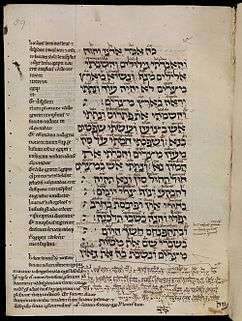Ezekiel 9
| Ezekiel 9 | |
|---|---|
 Book of Ezekiel 30:13–18 in an English manuscript from the early 13th century, MS. Bodl. Or. 62, fol. 59a. A Latin translation appears in the margins with further interlineations above the Hebrew. | |
| Book | Book of Ezekiel |
| Bible part | Old Testament |
| Order in the Bible part | 26 |
| Category | Nevi'im |
Ezekiel 9 is the ninth chapter of the Book of Ezekiel in the Hebrew Bible or the Old Testament of the Christian Bible. This book contains the prophecies spoken by the prophet Ezekiel, and is one of the Books of the Prophets.[1] In the New King James Version, this chapter is sub-titled "The Wicked Are Slain".[2]
Text
- The original text is written in Hebrew language.
- This chapter is divided into 11 verses.
Textual versions
Some most ancient manuscripts containing this chapter in Hebrew language:
- Masoretic Text (10th century)
Ancient translations in Koine Greek:
- Septuagint
- Theodotion version (~AD 180)
Verse 4
Letter taw in Paleo-Hebrew alphabet.
- And the Lord said unto him,
- Go through the midst of the city, through the midst of Jerusalem,
- and set a mark upon the foreheads of the men
- that sigh and that cry for all the abominations
- that be done in the midst thereof.[3]
- that sigh and that cry for all the abominations
- "Mark" (Hebrew: תו tāw): interpreted as a "sign of exemption from judgment" (also in Ezekiel 9:6).[4] The word "tāw" for "mark" is also for calling the last letter in Hebrew alphabet; in Paleo-Hebrew alphabet and Phoenician alphabet it was written "somewhat like the English X,"[5][6] (compare Revelation 7:3-4).[7] Montfaucon states that some ancient Samaritan coins have the letter "thau" on them in the form of a cross,[8] so do the coins of the Maccabees.[6] Gesenius wrote that the Arabic equivalent of this word refers to "a sign in the form of a cross branded on the thigh or neck of horses and camels."[6]
Verse 6
- “Utterly slay old and young men, maidens and little children and women;
- but do not come near anyone on whom is the mark;
- and begin at My sanctuary.”
- So they began with the elders who were before the temple. (NKJV)[9]
- "On whom is the mark": gives a hint that some people will survive ("such as those with the special mark on their foreheads").[10]
- "The elders": same as those in Ezekiel 8:16.[7]
- "Mark": see notes on Ezekiel 9:4.
Verse 11
- Just then, the man clothed with linen,
See also
- Related Bible parts: Hebrews 1, Revelation 2 Revelation 7, Revelation 9, Revelation 14, Revelation 22
Notes and references
- ↑ Theodore Hiebert, et al. 1996. The New Interpreter's Bible: Volume VI. Nashville: Abingdon.
- ↑ Ezekiel 9:1-11: NKJV
- ↑ Ezekiel 9:4
- ↑ Brown, Francis; Briggs, Charles A.; Driver, S. R. The Brown-Driver-Briggs Hebrew and English Lexicon. Hendrickson Publishers; Reprint edition (1994). ISBN 978-1565632066. "tav".
- ↑ Bromiley 1995, p. 508.
- 1 2 3 Gesenius, H. W. F. Gesenius' Hebrew and Chaldee Lexicon to the Old Testament Scriptures: Numerically Coded to Strong's Exhaustive Concordance, with an English Index. Samuel Prideaux Tregelles (Translator). Baker Book House; 7th edition. 1979. תָּו
- 1 2 The New Oxford Annotated Bible with the Apocrypha, Augmented Third Edition, New Revised Standard Version, Indexed. Michael D. Coogan, Marc Brettler, Carol A. Newsom, Editors. Publisher: Oxford University Press, USA; 2007. pp. 1191-1192 Hebrew Bible. ISBN 978-0195288810
- ↑ Bernard de Montfaucon. Palaeographia Graeca l. 2. c. 3.
- ↑ Ezekiel 9:6
- ↑ Clements 1996, p. 47.
- ↑ Ezekiel 9:11
- ↑ Brown, Francis; Briggs, Charles A.; Driver, S. R. The Brown-Driver-Briggs Hebrew and English Lexicon. Hendrickson Publishers; Reprint edition (1994). ISBN 978-1565632066. "bad".
- ↑ Gesenius, H. W. F. Gesenius' Hebrew and Chaldee Lexicon to the Old Testament Scriptures: Numerically Coded to Strong's Exhaustive Concordance, with an English Index. Samuel Prideaux Tregelles (Translator). Baker Book House; 7th edition. 1979. בָּד
Bibliography
- Bromiley, Geoffrey W. (1995). International Standard Bible Encyclopedia: vol. iv, Q-Z. Eerdmans.
- Clements, Ronald E (1996). Ezekiel. Westminster John Knox Press. ISBN 9780664252724.
- Joyce, Paul M. (2009). Ezekiel: A Commentary. Continuum. ISBN 9780567483614.
- Ulrich, Eugene, ed. (2010). The Biblical Qumran Scrolls: Transcriptions and Textual Variants. Brill.
External links
Jewish
Christian
This article is issued from
Wikipedia.
The text is licensed under Creative Commons - Attribution - Sharealike.
Additional terms may apply for the media files.